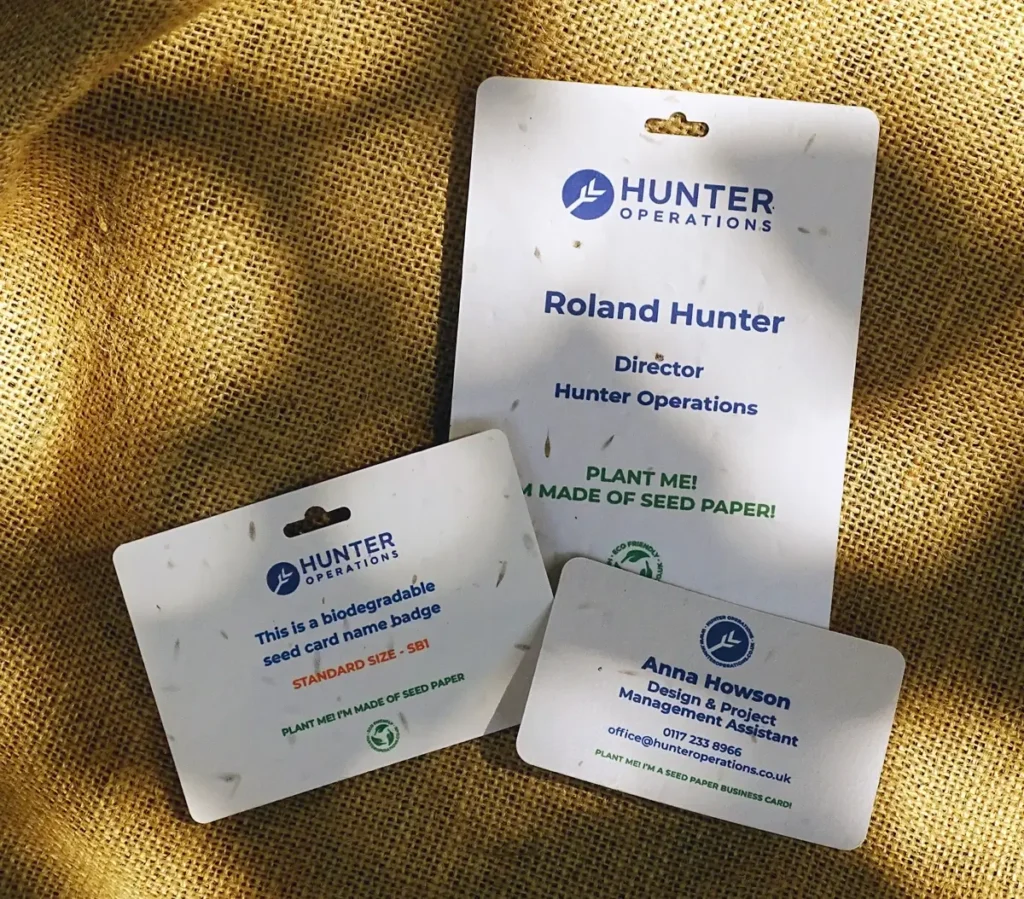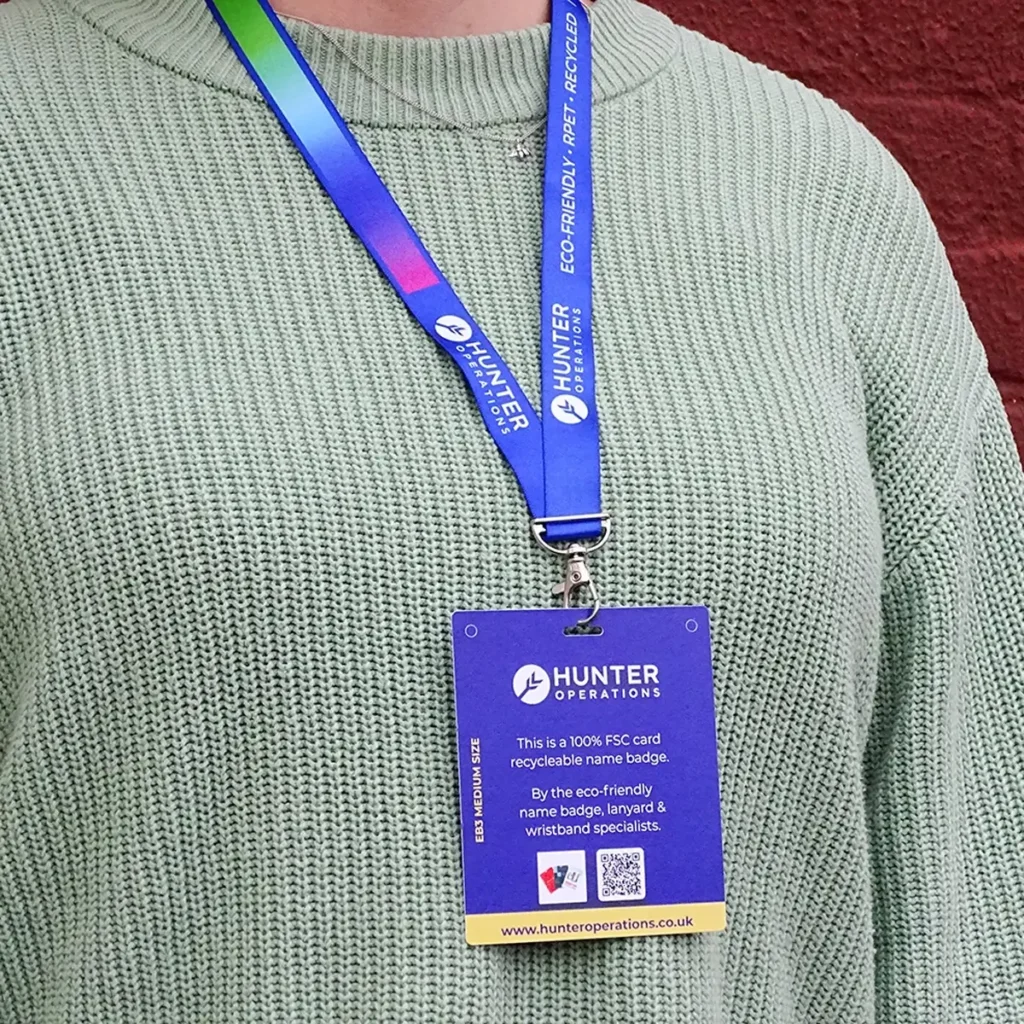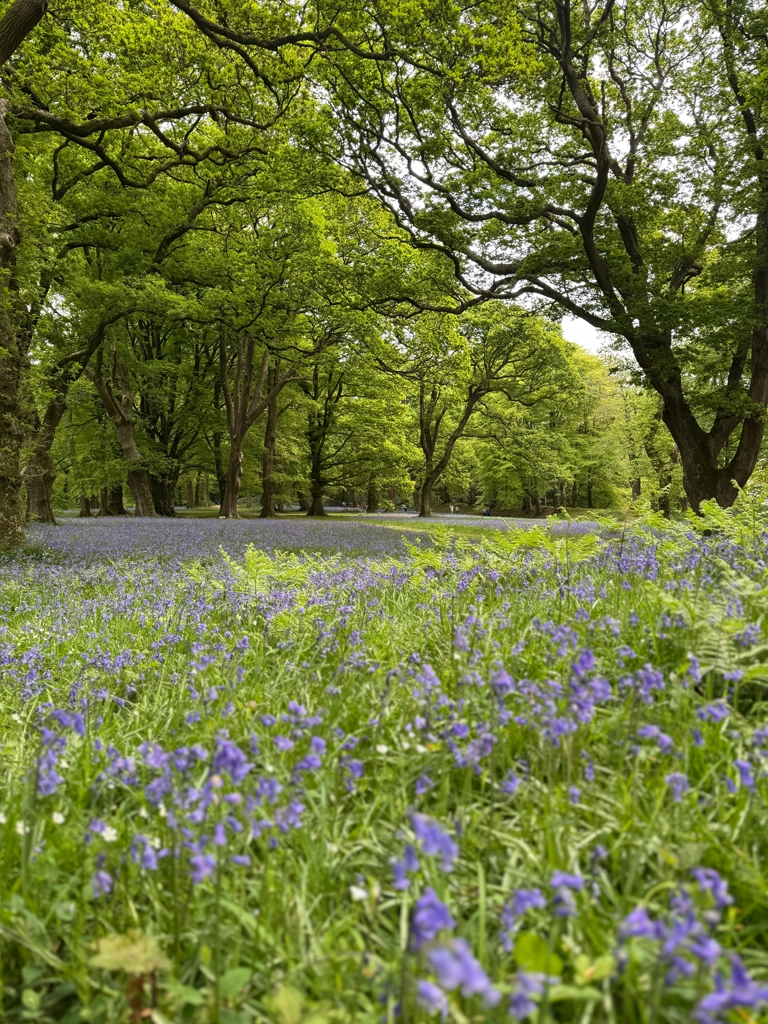A well-designed badge does more than identify someone – it communicates professionalism, reinforces brand identity, and even sparks conversation. At Hunter Operations, we’ve helped hundreds of clients create name badges that are both functional and visually aligned with their business goals and values.
In this guide, we’ll walk you through how to design name badges that not only look great but truly reflect your brand’s personality and purpose. We’ll cover layout, colour, typography, material selection, sustainability, and messaging — everything you need to make informed pre-purchase decisions and work confidently with your badge supplier.
Why Badge Design Matters
Badges are no longer a simple name-on-card exercise. They’ve become part of the brand toolkit – just like your logo, website, or business card. When done well, badges can:
- Strengthen visual brand identity
- Enhance the event experience
- Improve networking and engagement
- Reinforce values such as sustainability, inclusivity, and creativity
- Serve as a memorable takeaway or keepsake
Think of each badge as a mini billboard for your organisation.
Step 1: Start with the Badge Purpose
Ask yourself: What’s the primary role of the badge at your event? This will inform every design decision.
Common Badge Functions:
- Attendee identification
- Role or access level differentiation (VIP, Speaker, Staff)
- Event programme reference (schedule or QR code)
- Promotional messaging or branding
- Sustainable branding statement (e.g. seed paper or RPET)
Tip: Make a list of all the information the badge needs to display. This helps avoid clutter later.
Step 2: Choose the Right Badge Format & Size
Popular Sizes:
- 85.6mm wide x 54mm high (small credit card)
- 97mm wide x 86mm high (standard for more info)
- 105mm wide x 148mm high (large)
Landscape vs Portrait:
- Landscape is often better for short names and job titles
- Portrait provides more vertical space for event branding or schedules
Materials to Consider:
- FSC-Certified Card – Recyclable, budget-friendly
- Seed Paper – Plantable, eco-conscious branding
- Wooden or Cork – Premium, natural aesthetic
- Reusable Holder + Insert – Great for regular attendees or multi-day use
Step 3: Align with Your Visual Brand Identity
Your badge should look like it belongs to your business. This means applying your brand consistently:
Key Design Elements:
- Logo – Usually top left or centred
- Brand Colours – Match your palette or create a high-contrast combo
- Typography – Use your brand fonts if possible, or clear alternatives
- Imagery/Icons – Optional, but can support role categories or themes
Real-World Examples:
- A creative agency might use bold colours and expressive typography
- A charity might opt for soft, approachable fonts and calming colours
- A tech brand may choose minimalist design with sharp lines and icons
Hunter Tip: Don’t overcrowd. Leave white space for balance.
Step 4: Make Names and Titles Easy to Read
It sounds obvious, but name and job title legibility is critical — and it’s where many badge designs fall down.
Legibility Guidelines:
- Font Size: First name = 24–36pt / Surname = 18–28pt / Job title = 14–18pt
- Contrast: Dark text on light backgrounds is usually easiest
- Font Choice: Sans serif fonts like Arial, Helvetica, or Open Sans are cleaner at smaller sizes
Consider hierarchy: What’s most important? Usually the name. Then job title. Then organisation.
Step 5: Incorporate Sustainability Without Sacrificing Style
Sustainable materials are not only expected by many attendees — they’re a powerful expression of your brand values. The good news is you don’t have to sacrifice visual impact.
Eco-Friendly Options at Hunter Operations:
- Seed Paper Badges: Embedded with wildflower or herb seeds; plant after use
- Recycled Card: Available in white, kraft, or custom colours
- Bamboo or Cork: Natural textures, laser-etched or screen printed
- RPET Holders: Made from recycled plastic bottles, paired with recycled lanyards
Make it known — include a message like:
- “This badge is made from 100% recycled card”
- “Please take me home and plant me!”
Step 6: Consider Variable Data and Access Control
If your badges require personalised details (name, role, company), think about how that data will be integrated into your design.
Design Considerations:
- Leave enough space in your layout for long names
- Plan for dynamic text fields in your print template
- Use colour coding or icons for access levels (e.g. Speaker, VIP)
- Integrate QR codes or barcodes for check-in or content access
Ask your supplier about secure data handling and printing from spreadsheets.
Step 7: Match Your Badge to the Right Accessory
Badges are usually worn on lanyards, clips, or magnets. The wrong combination can lead to spinning, flipping, or unreadable badges on the day.
Options to Consider:
- Eco Lanyards: RPET, bamboo, kraft paper
- Printed Lanyards: Custom branding for extra exposure
- Metal or Wooden Clips: Avoid plastic for sustainability
- Magnetic Fasteners: Best for premium events (but not great for seed paper)
Always check lanyard length and breakaway requirements, especially for public or school events.
Step 8: Keep It Functional Under Real Conditions
Badge design shouldn’t just look good on screen — it must perform in the real world:
Ask Yourself:
- Will it hold up outdoors or in the rain?
- Will it smudge if handled often?
- Is it visible from a distance?
- Is the content still readable when worn?
You may need to test a few prototypes before committing to the final print run.
Step 9: Leverage Badges as Brand Messaging Tools
Think beyond the name and logo. Badges can include mini messages that reinforce your values:
- “Here to Connect”
- “Ask Me About Our Green Goals”
- “Proud Supporter of Inclusive Events”
You can also include social handles, hashtags, or campaign slogans.
For example:
- @hunteroperations | #ThinkEcoPrint
This subtle branding encourages interaction and amplifies your campaign beyond the badge.
Step 10: Work with a Supplier Who Understands Branding
A good badge supplier doesn’t just print — they consult, advise, and help you bring your vision to life. At Hunter Operations, we provide:
- Badge templates that match your brand
- Expert artwork checks
- Sustainable material guidance
- Proofing and sampling
- Lanyard and badge pairing advice
- Pre-assembly options for quick handouts
We make sure your badge is an asset to your event — not a stress point.
Final Thoughts
Designing custom name badges isn’t just about printing a name — it’s about projecting your brand, values, and purpose from the moment someone walks through the door.
With thoughtful design, careful material selection, and clear communication with your supplier, you can turn a simple rectangle of card into a strategic, sustainable brand asset.
Whether you’re planning a 50-person workshop or a 5,000-person exhibition, investing in badge design pays dividends in perception, experience, and sustainability.





